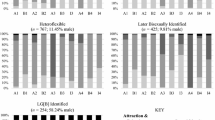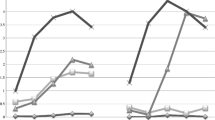Abstract
Sexual minority (lesbian and gay, bisexual, mostly heterosexual) individuals are at an increased risk for hazardous drinking than heterosexual individuals, but little is known about the nature of the disparities as adolescents reach adulthood. We used four waves of a nationally representative data set, the National Longitudinal Study of Adolescent Health (Add Health), to examine disparities of hazardous drinking outcomes between sexual minority and heterosexual men and women from adolescence to young adulthood. Participants were 14–18 years old at the first assessment (N = 12,379; 53 % female) and 27–31 years old at the fourth assessment. At the fourth assessment, 13 % self-identified as sexual minority individuals, 16 % were Hispanic, and 36 % were of minority race, including primarily African Americans (60 %) and Asian Americans (18 %). There were clear hazardous drinking disparities between sexual minority individuals and heterosexual individuals over time. During adolescence, sexual minority individuals, particularly females, reported higher levels of hazardous drinking. As study participants reached adulthood, the magnitude of the hazardous drinking disparities increased among sexual minorities, sexual minority men in particular. Additional research is needed to better understand the developmental mechanisms that underlie the emerging sexual orientation related disparities of hazardous drinking in young adulthood.


Similar content being viewed by others
Notes
For the binge drinking outcome (Table 2), the initial level of binge drinking among gay/mostly gay youth was significantly lower than the other groups. Mostly heterosexual individuals did not demonstrated significantly greater initial binge drinking levels than the bisexual or heterosexual youth. All other findings were replicated between the drunkenness and binge drinking outcomes.
For the binge drinking outcome (Table 2), heterosexual males exhibited a similar growth rate to sexual minority males. Furthermore, binge drinking among heterosexual females increased significantly, but modestly, over time. All other findings were replicated between the drunkenness and binge drinking outcomes.
References
Arnett, J., & Taber, S. (1994). Adolescence terminable and interminable: When does adolescence end? Journal of Youth & Adolescence, 23, 517–537.
Austin, S. B., Roberts, A. L., Corliss, H. L., & Molnar, B. E. (2008). Sexual violence victimizatio history and sexual risk indices in a community-based urban cohort of “mostly heterosexual” and heterosexual young women. American Journal of Public Health. doi:10.2105/AJPH.2006.099473.
Bandura, A. (1977). Social learning theory. New York: General Learning Press.
Bollen, K. A., & Curran, P. J. (2006). Latent curve models: A structural equation approach. Hoboken, NJ: Wiley Series in Probability and Mathematical Statistics.
Bondy, S. J., Rehm, J., Ashley, M. J., Walsh, G., Single, E., & Room, R. (1999). Low-risk drinking guidelines: The scientific evidence. Canadian Journal of Public Health, 90(4), 264–270.
Brown, S. A., McGue, M., Maggs, J., Schulenberg, J., Hingson, R., Swartzwelder, S., et al. (2008). A developmental perspective on alcohol and youths 16 to 20 years of age. Pediatrics. doi:10.1542/peds.2007-2243D.
Caldwell, L. L., Kivel, B. D., Smith, E. A., & Hays, D. (1998). The leisure context of adolescents who are lesbian, gay male, bisexual, and questioning their sexual idenitities: An exploratory study. Journal of Leisure Research, 101(3), 895–902.
Carpiano, R. M., Kelly, B. C., Easterbrook, A., & Parsons, J. T. (2011). Community and drug use among gay men: The role of neighborhoods and networks. Journal of Health and Social Behavior. doi:10.1177/0022146510395026.
Chantala, K. (2003). Introduction to analyzing Add Health data. http://www.cpc.unc.edu/projects/addhealth/files/analyze.pdf. Accessed December 7, 2011.
Cochran, S. D., Ackerman, D., Mays, V. M., & Ross, M. W. (2004). Prevalence of non-medical drug use and dependence among homosexually active men and women in the US population. Addiction. doi:10.1111/j.1360-0443.2004.00759.x.
Cochran, S. D., Grella, C. E., & Mays, V. M. (2012). Do substance use norms and perceived drug availability mediate sexual orientation differences in patterns of substance use? Results from the California Quality of Life Survey II. Journal of Studies on Alcohol and Drugs, 73(4), 675–685.
Coker, T. R., Austin, S. B., & Schuster, M. A. (2010). The health and health care of lesbian, gay, and bisexual adolescents. Annual Review of Public Health. doi:10.1146/annurev.publhealth.012809.103636.
Cooper, M. L., Russell, M., & George, W. H. (1988). Coping, expectancies, and alcohol abuse: A test of social learning formulations. Journal of Abnormal Psychology, 97(2), 218–230.
Corliss, H. L., Rosario, M., Wypij, D., Fisher, L. B., & Austin, S. B. (2008). Sexual orientation disparities in longitudinal alcohol use patterns among adolescents: Findings from the growing up today study. Archives of Pediatric Adolescent Medicine. doi:0.1001/archpedi.162.11.1071.
Corliss, H. L., Wadler, B. M., Jun, H. J., Rosario, M., Wypij, D., Frazier, A. L., et al. (2012). Sexual-orientation disparities in cigarette smoking in a longitudinal cohort study of adolescents. Nicotine & Tobacco Research. doi:10.1093/ntr/nts114.
Faulkner, A. H., & Cranston, K. (1998). Correlates of same-sex sexual behavior in a random sample of Massachusetts high school students. American Journal of Public Health, 88(2), 262–266.
Friedman, M. S., Marshal, M. P., & Stall, R. (2008). Gay-related development, early abuse and adult health outcomes among gay males. AIDS & Behavior, 12(6), 897–902.
Grant, B. F., Stinson, F. S., Dawson, D. A., Chou, S. P., Dufour, M. C., Compton, W., et al. (2004). Prevalence and co-occurrence of substance use disorders and independent mood and anxiety disorders: Results from the national epidemiologic survey on alcohol and related conditions. Archives of General Psychiatry. doi:10.1001/archpsyc.61.8.807.
Halpern, C. T., Young, M. L., Waller, M. W., Martin, S. L., & Kupper, L. L. (2004). Prevalence of partner violence in same-sex romantic and sexual relationships in a national sample of adolescents. Journal of Adolescent Health, 35, 124–131.
Harris, K. M. (2009). The national longitudinal study of adolescent health (Add Health), waves I & II, 1994–1996; Wave 1II, 2001–2002; Wave 4, 2007–2009 Chapel Hill. NC: Carlonia Population Center.
Hatzenbuehler, M. L., Corbin, W. R., & Fromme, K. (2011). Discrimination and alcohol-related problems among college students: A prospective examination of mediating effects. Drug and Alcohol Dependence, 115(4). doi:10.1016/j.drugalcdep.2010.11.002.
Hu, L., & Bentler, P. M. (1999). Cutoff criteria for fit indexes in covariance structure analysis: Conventional criteria versus new alternatives. Structural Equation Modeling, 6(1). doi:10.1080/10705519909540118.
Institute of Medicine. (2011). The health of lesbian, gay, bisexual, and transgender people: Building a foundation for better understanding. Washington, DC: The National Academic Press.
Johnston, L. D., O’Malley, P. M., & Bachman, J. G. (2003). Monitoring the future: National survey results on drug use, 1975–2002, Vol. 1. NIH Publication No. 03-5375, Bethesda, MD: Department of Health and Human Services.
King, M., Semlyen, J., Tai, S., Killaspy, H., Osborn, D., Popelyuk, D., et al. (2008). A systematic review of mental disorder, suicide, and deliberate self harm in lesbian, gay and bisexual people. BMC Psychiatry. doi:10.1186/1471-244x-8-70.
Marshal, M. P., Friedman, M. S., Stall, R., King, K. M., Miles, J., Gold, M. A., et al. (2008). Sexual orientation and adolescent substance use: A meta-analysis and methodological review*. Addiction. doi:10.1111/j.1360-0443.2008.02149.x.
Marshal, M. P., Friedman, M. S., Stall, R., & Thompson, A. L. (2009). Individual trajectories of substance use in lesbian, gay and bisexual youth and heterosexual youth. Addiction. doi:10.1111/j.1360-0443.2009.02531.x.
Marshal, M. P., King, K. M., Stepp, S. D., Hipwell, A., Smith, H., Chung, T., et al. (2012). Trajectories of alcohol and cigarette use among sexual minority and heterosexual girls. Journal of Adolescent Health. doi:10.1016/j.jadohealth.2011.05.008.
Meyer, I. H. (2003). Prejudice, social stress, and mental health in lesbian, gay, and bisexual populations: Conceptual issues and research evidence. Psychological Bulletin. doi:10.1037/0033-2909.129.5.674.
Mokdad, A., Marks, J. S., Stroup, D. F., & Gerberding, J. L. (2004). Actual causes of death in the United States, 2000. JAMA, the Journal of the American Medical Association, 291(10), 1238–1245.
Muthén, L. K., & Muthén, B. O. (1998–2010). Mplus 6.0 [Computer Software]. Los Angeles, CA: Muthén & Muthén.
Naimi, T. S., Brewer, R. D., Mokdad, A., Denny, C., Serdula, M. K., & Marks, J. S. (2003). Binge drinking among US adults. Journal of the American Medical Association. doi:10.1001/jama.289.1.70.
Needham, B. (2011). Sexual attraction and trajectories of mental health and substance use during the transition from adolescence to adulthood. Journal of Youth and Adolescence. doi:10.1007/s10964-011-9729-4.
Read, J. P., Wood, M. D., & Capone, C. (2005). A prospective investigation of relations between social influences and alcohol involvement during the transition into college. Journal of Studies on Alcohol and Drugs, 66(1), 23–34.
Robin, L., Brener, N. D., Donahue, S. F., Hack, T., Hale, K., & Goodenow, C. (2002). Associations between health risk behaviors and opposite-, same-, and both-sex sexual partners in representative samples of Vermont and Massachusetts high school students. Archives of Pediatric and Adolescent Medicine, 156(4), 349–355.
Satorra, A., & Bentler, P. M. (2001). A scaled difference chi-square test statistic for moment structure analysis. Psychometrika, 66, 507–514.
Sloan, F. A., & Grossman, D. S. (2011). Alcohol consumption in early adulthood and schooling completed and labor market outcomes at midlife by race and gender. American Journal of Public Health. doi:10.2105/ajph.2010.194159.
Smith, A. M., Lindsay, J., & Rosenthal, D. A. (1999). Same sex attraciton, drug injection and binge drinking among Australian adolescents. Australian and New Zealand Journal of Public Health, 23(6), 643–646.
Talley, A. E., Sher, K. J., Steinley, D., Wood, P. K., & Littlefield, A. K. (2012). Patterns of alcohol use and consequences among empirically derived sexual minority subgroups. Journal of Studies on Alcohol and Drugs, 73(2), 290–302.
Trocki, K. F., Drabble, L., & Midanik, L. (2005). Use of heavier drinking contexts among heterosexuals, homosexuals and bisexuals: Results from a National Household Probability Survey. Journal of Studies on Alcohol and Drugs, 66(1), 105–110.
U.S. Department of Health and Human Services. (2012). Healthy people 2020. Retrieved October 05 2012, from http://www.hhs.gov/ash/oah/resources-and-publications/healthy-people-2020.html.
Valentine, G., & Skelton, T. (2003). Finding oneself, losing oneself: The lesbian and gay ‘scene’ as a paradoxical space. International Journal of Urban and Regional Research. doi:10.1111/j.0309-1317.2003.00487.x.
Walder-Haugrud, L. K., Gratch, L. V., & Magruder, B. (1997). Victimization and perpetration rates of violence in gay and lesbian relationships: Gender issues explored. Violence and Victims, 12, 173–184.
Wechsler, H., Dowdall, G. W., Davenport, A., & Rimm, E. B. (1995). A gender-specific measure of binge drinking among college students. American Journal of Public Health, 85(7), 982–985.
Wechsler, H., & Isaac, N. (1992). Binge drinkers at massachusetts colleges: Prevalence, drinking style, time trends, and associated problems. JAMA, the Journal of the American Medical Association, 267(21), 2929–2931.
Whitbeck, L. B., Chen, X., Hoyt, D. R., Tyler, K. A., & Johnson, K. S. (2004). Mental disorder, subsistence strategies, and victimization among gay, lesbian, and bisexual homeless and runaway adolescents. Journal of Sex Research, 41(4), 329–342.
Acknowledgments
The production of the manuscript was supported by grants awarded to Dr. Michael Marshal from the National Institute of Drug Abuse (DA030385 & DA026312).
Author Contributions
SD and MP developed the initial study idea. SD conducted the analyses, interpreted the results and drafted the manuscript. MP participated in the implementation of the project and helped interpret the results and draft the manuscript. JC was involved in the data analyses, interpreting the results, and drafting the manuscript. CB, MF, FA, and TH helped interpret the results, develop the implications of the study findings as well as revise the manuscript. All authors have read and approved the final manuscript.
Author information
Authors and Affiliations
Corresponding author
Rights and permissions
About this article
Cite this article
Dermody, S.S., Marshal, M.P., Cheong, J. et al. Longitudinal Disparities of Hazardous Drinking Between Sexual Minority and Heterosexual Individuals from Adolescence to Young Adulthood. J Youth Adolescence 43, 30–39 (2014). https://doi.org/10.1007/s10964-013-9905-9
Received:
Accepted:
Published:
Issue Date:
DOI: https://doi.org/10.1007/s10964-013-9905-9




